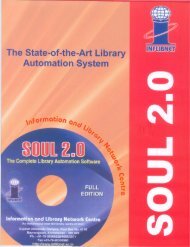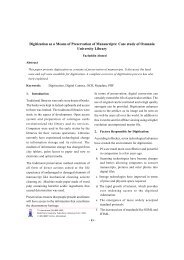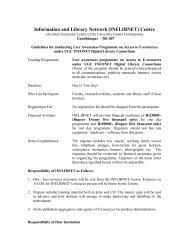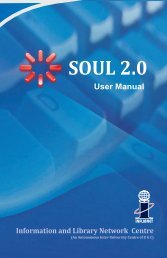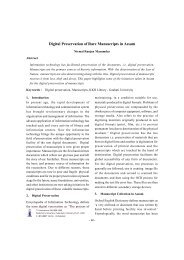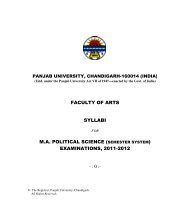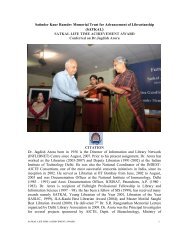Vol.19- No.1 (Jan-Mar, 2012) - INFLIBNET Centre
Vol.19- No.1 (Jan-Mar, 2012) - INFLIBNET Centre
Vol.19- No.1 (Jan-Mar, 2012) - INFLIBNET Centre
Create successful ePaper yourself
Turn your PDF publications into a flip-book with our unique Google optimized e-Paper software.
submission of Ph.D theses vide UGC Regulation 2009 (minimumstandards and Procedure for award of M.Phil / Ph.D Degree).Accordingly, all universities are required to submit electronicversion of theses into Shodhganga. He mentioned that theuniversities are also free to set-up their own ETD repositorieswith help of IN FLIBN ET <strong>Centre</strong>. Dr. Arora mentioned that theIN FLIBN ET <strong>Centre</strong>, under the Shodhganga initiative, will provideanti-plagiarism software to universities that are signatory to theMoU on Shodhganga to facilitate detection of plagiarism in thetheses before its submission to the University.Dr. Vinod Chachra gave a bird's eye view of initiatives taken atthe international level for creating and managing ETDs. He opinedthat free and open access should be provided to theses anddissertations submitted to the universities across the gtobe. Heexplained different steps involved in creating and managingETDs. He emphasized that the tools used for creating andmanaging ETDs should be scalable in nature, the discovery toolsneed to be enhanced so as to provide greater visibility to theETDs. He also discussed the features of NDLTD Union Catalogue,phases of its development and OAljPMH protocols used forharvesting the metadata from member universities. He elaboratedon strategies used for promotion, adoption, creation,dissemination and preservation of ETDs by the N DLTD andhighlighted the use and importance of VALET, an open source,customizable, web based interface that enables remote users tosubmit content to FEDO RA based digital object repository. Dr.Chachra also observed that more concerted efforts need to betaken to evolve a strategy for long-term preservation of ETDarchives. Sh. Manoj Kumar K extended a warm vote of thanksto the delegates for turning up in large number as well asdignitaries and experts for their time and support. He alsoexpressed gratitude to the Vice Chancellor, Rector and otherauthorities of JNU for hosting the National Seminar.Technical sessions were organised in six different tracks namelyi) ETD: Policy Setting and enforcement; ii) Shodhganga: CentralRepository of Electronic Theses and Dissertations; iii) Digitizationand Digital Archiving of Theses and D~sertations; iv) ETD SystemsSelection and Use; v) ETD: Case studies; and vi) Copyright andOther Related Issues concerning ETDs.Technical Session - I ;ETDs; Policy Settin'l' and EnforcementChairperson: Sh. Subhash Deshmukh, University Librarian,GGSIP, New DelhiRapporteur: Dr. Anup Kr. Das, jNU, New DelhiDr. Dinesh Katre, in his presentation, highlighted the objectivesof National Digital Preservation Programme that includesconducting research and development in digital preservation,develop pilot digital repositories, define digital preservationstandards and provide inputs to Department of IT for layingdown national policy and strategy for long term preservation.He dwelt on the importance of long-term preservation ofscholarly content. He highlighted that not only final output ofthe theses and dissertations be archived and preserved but thesoftware, raw data, artefacts used for arriving at the final outputor findings should also be preserved and made accessible tofuture researchers so that duplication of efforts and dissipationof energy can be avoided. Dr. Katre elaborated on the initiativestaken at the international level for digital preservation likeNational Digital Infrastructure and Preservation Programme(NDIIPP, USA), NESTOR (Network of Expertise in Long TermStorage of Digital Resources, Germany; CASPER (Cultural. Artisticand Scientific knowledge for Preservation, Access and Retrieval.UK), Digital Preservation Europe (DPE), Digital Curation <strong>Centre</strong>(DCC).Dr. ARD Prasad, DRTC, Bangalore presented a comparativeanalysis of metadata schema used by NDLTD, UKETD,Shodhganga of IN FLIBN ET and demonstrated visible variationsin all the three schemas. He mentioned that there is no W3standard available for ETDs. Dr. Prasad advocated that thereshould be a single standard metadata schema which should beuniformly followed by the ETDs across the country. He suggestedthat the metadata schema should be amenable for crosswalkwith ETDMS and U KETD- DC and should be exposed to theWeb for validation. He opined that the use of standard metadataschema will definitely improve interoperability among themetadata schemas and facilitate conversion and exchange ofmeta data and enable cross domain meta data harvesting andmetadata searches.Technical Session - II; Shodh'l'an'l'a;An Dpportunity for University Libraries in IndiaChairperson: Dr. jagdish Arora, Director, IN FLIBN ETRapporteur: Mr. Gulam Rasul. jNU, New DelhiMr. Manoj Kumar K, Scientist-D (CS) explained the objectives,coverage and submission workflow of Shodhganga. Heexplained that Shodhganga is an open access re[X)sitory of thesesand dissertations submitted to Indian universities as per the UGCNotification (2009). It serves as platform for the research scholarsto de[X)sit their Ph.D theses and make it accessible to the worldwide community of scholars in open access mode. The research6 -----------------------------Vol. 19, <strong>No.1</strong> Uanuary to <strong>Mar</strong>ch <strong>2012</strong>)



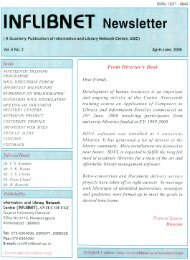


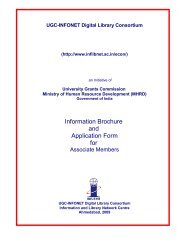
![Uni of Delhi_MA_History[1]. - INFLIBNET Centre](https://img.yumpu.com/48586372/1/190x245/uni-of-delhi-ma-history1-inflibnet-centre.jpg?quality=85)
